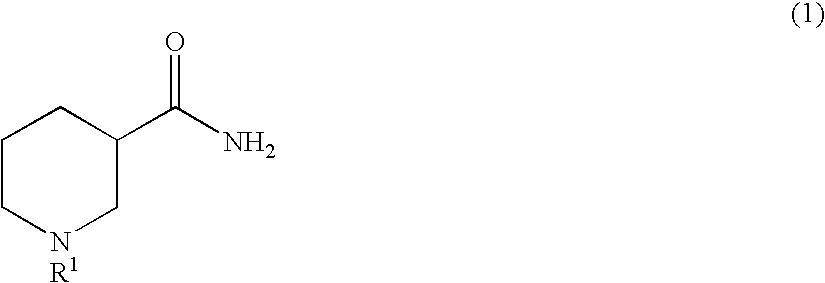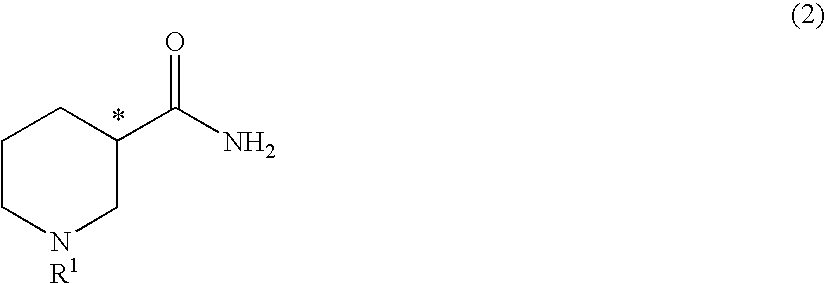Method for producing optically active 3-aminopiperidine or salt thereof
a technology of 3aminopiperidine and aminopiperidine, which is applied in the direction of organic chemistry, organic chemistry, chemistry apparatus and processes, etc., can solve the problems of industrial implementation, high cost and high danger, and the method of conventional art 1, and achieves the effect of easy production, inexpensive and readily available raw materials
- Summary
- Abstract
- Description
- Claims
- Application Information
AI Technical Summary
Benefits of technology
Problems solved by technology
Method used
Image
Examples
example 1
Selective hydrolysis of (R)- or (S)-1-nipecotamide in racemate
[0197]Each microorganism shown in Tables 1 and 2 was inoculated in a medium (8 ml, glycerol 1.0%, peptone 0.5%, malt extract 0.3%, yeast extract 0.3%, isovaleronitrile 0.1%, pH 7.0) sterilized in vitro, and stirred and cultivated at 30° C. for 72 hours. After completion of the cultivation, the bacterial cells were collected by centrifugal separation, and suspended in 100 mM phosphate buffer (1 ml, pH 7.0). The bacterial cell suspension (0.1 ml) was mixed with 100 mM phosphate buffer containing 0.2% of racemic 1-benzylnipecotamide (0.1 ml, pH 7.0), and the mixture was shaken at 30° C. for 24 hours. After completion of the reaction, solid substance was removed by centrifugal separation, and then the substrate and product in the reaction mixture were analyzed by high performance liquid chromatography to determine the conversion rate (%) and optical purity (% ee). The results are shown in Tables 1 and 2. The KNK-J915 strain i...
example 2
Method for producing (R)-1-benzylnipecotamide
[0203]
[0204]Cupriavidus sp. KNK-J915 stain (FERN BP-10739) was inoculated in a medium (glycerol 1.0%, peptone 0.5%, malt extract 0.3%, yeast extract 0.3%, isovaleronitrile 0.1%, pH 7.0) sterilized in a Sakaguchi flask, and stirred and cultivated at 30° C. for 72 hours. After completion of the cultivation, the bacterial cells were collected by centrifugal separation, and suspended in 100 mM phosphate buffer (pH 7.0) to obtain a 20-fold concentrated bacterial cell suspension. To the bacterial cell suspension (100 ml), racemic 1-benzylnipecotamide (5 g) was added. The pH of the solution was adjusted to 7 using NaOH, and then the mixture was shaken at 30° C. for 60 hours. After completion of the reaction, solid substance such as bacterial cells was removed by centrifugal separation from the reaction mixture, and the pH of the mixture was adjusted to 10.0 using NaOH. The mixture was stirred at room temperature for 1 hour, and then precipitated...
example 3
Selective Hydrolysis of R-Enantiomer in Racemic Nipecotamide
[0205]Cupriavidus sp. KNK-J915 strain (FERM BP-10739) was cultivated by the method of Example 1 to prepare a bacterial cell suspension. The bacterial cell suspension (0.1 ml) was mixed with 100 mM phosphate buffer containing 1.0 to 5.0% of racemic nipecotamide (0.1 ml, pH 7.0), and the mixture was shaken at 30° C. for 35 hours. After completion of the reaction, solid substance such as bacterial cells was removed by centrifugal separation, and then a substrate and a product in the reaction mixture were reacted with benzyl chlorocarbonate for derivatization. The resulting derivative was analyzed by high performance liquid chromatography to determine the conversion rate (%) and optical purity (ee %). The results are listed in Table 3.
[0206]High Performance Liquid Chromatographic Analysis Conditions
[0207]Analysis of Conversion Rate
[0208]Column: YMC-A303 (4.6 mmφ×250 mm, manufactured by YMC Inc., Eluent: 20 mM phosphoric acid aq...
PUM
| Property | Measurement | Unit |
|---|---|---|
| Optical activity | aaaaa | aaaaa |
Abstract
Description
Claims
Application Information
 Login to View More
Login to View More - R&D
- Intellectual Property
- Life Sciences
- Materials
- Tech Scout
- Unparalleled Data Quality
- Higher Quality Content
- 60% Fewer Hallucinations
Browse by: Latest US Patents, China's latest patents, Technical Efficacy Thesaurus, Application Domain, Technology Topic, Popular Technical Reports.
© 2025 PatSnap. All rights reserved.Legal|Privacy policy|Modern Slavery Act Transparency Statement|Sitemap|About US| Contact US: help@patsnap.com



